Slow and Steady Improvements in Persistent Southern Plains Drought
Key Points
- Drought has improved but continues across much of the Southern Plains.
- Exceptional Drought (D4) persists in southeastern New Mexico and along the Texas/Louisiana state line.
- More rain is expected over the winter months, bringing continued drought improvement.
The U.S. Drought Monitor depicts the location and intensity of drought across the country. The map uses 5 classifications: Abnormally Dry (D0), showing areas that may be going into or are coming out of drought, and four levels of drought (D1–D4).
The U.S. Drought Monitor is a joint effort of the National Oceanic and Atmospheric Administration, U.S. Department of Agriculture, and National Drought Mitigation Center.
U.S. Drought Monitor
D0 - Abnormally Dry
Abnormally Dry (D0) indicates a region that is going into or coming out of drought, according to the U.S. Drought Monitor. View typical impacts by state.
D1 – Moderate Drought
Moderate Drought (D1) is the first of four drought categories (D1–D4), according to the U.S. Drought Monitor. View typical impacts by state.
D2 – Severe Drought
Severe Drought (D2) is the second of four drought categories (D1–D4), according to the U.S. Drought Monitor. View typical impacts by state.
D3 – Extreme Drought
Extreme Drought (D3) is the third of four drought categories (D1–D4), according to the U.S. Drought Monitor. View typical impacts by state.
D4 – Exceptional Drought
Exceptional Drought (D4) is the most intense drought category, according to the U.S. Drought Monitor. View typical impacts by state.
The U.S. Drought Monitor depicts the location and intensity of drought across the country. The map uses 5 classifications: Abnormally Dry (D0), showing areas that may be going into or are coming out of drought, and four levels of drought (D1–D4).
The U.S. Drought Monitor is a joint effort of the National Oceanic and Atmospheric Administration, U.S. Department of Agriculture, and National Drought Mitigation Center.
This map is released every Thursday morning, with data valid through Tuesday at 7am Eastern.
Current Drought Conditions in the Southern Plains
- Extreme Drought (D3) conditions have been in place in the Southern Plains region since August 2019.
- Moderate (D1) or worse drought has been in the region since June 28, 2016. This is a new drought duration record for the Southern Plains; it has been 391 weeks since the Southern Plains was drought free.
- Kansas has experienced a one- to two-category improvement in drought over the last month, with parts of southwest Kansas now drought free.
- Oklahoma, especially western Oklahoma, including the Panhandle region, received 2–5 inches of rain over the past month. The Panhandle has been out of drought since June, but Extreme Drought (D3) persisted over the southwest (Harmon County, Greer County and surrounds) until early December.
- Extreme Drought (D3) continues over central Texas (including Austin, San Marcos, and San Antonio).
- Southeast New Mexico continues in Exceptional Drought (D4) (Chaves County and Eddy County).
- Louisiana, while not in the Southern Plains DEWS region, has seen increasing drought. 99.2% of the state is in Moderate Drought (D1) or worse, 63% of the state in Extreme Drought (D3) or worse, and 24% of the state is in Exceptional Drought (D4), which is down from 74% in November.
U.S. Drought Monitor 2-Month Change Map
Key Takeaway: Where most of the Southern Plains was in drought through the summer, rainfall over late fall has improved drought by three to four USDM drought categories over parts of eastern Kansas, central Oklahoma, and central, southern, and eastern Texas.
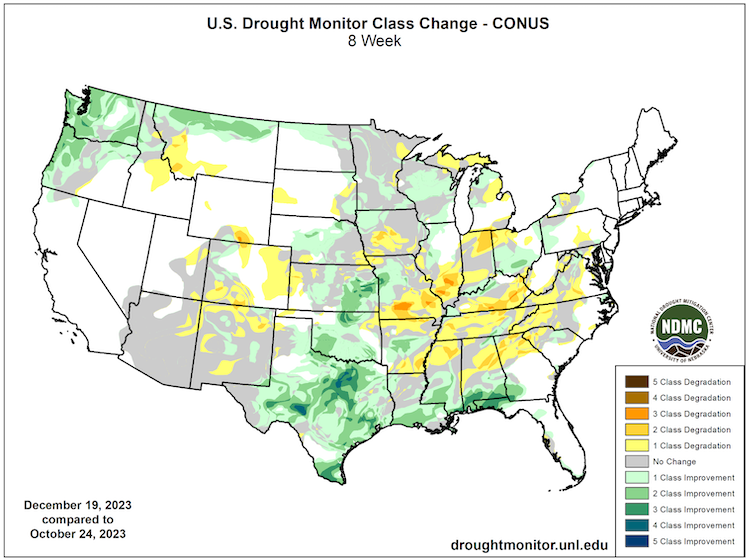
30-Day Percent of Normal Precipitation for the Southern Plains
Key Takeaway: A band from southern New Mexico and across western Texas (the Chihuahuan Desert region) missed out on needed precipitation over the last month. Severe to Exceptional Drought (D2–D4) continues in these areas. The Texas and Oklahoma Panhandles and southwest Kansas received a much-needed soaking in mid-December.
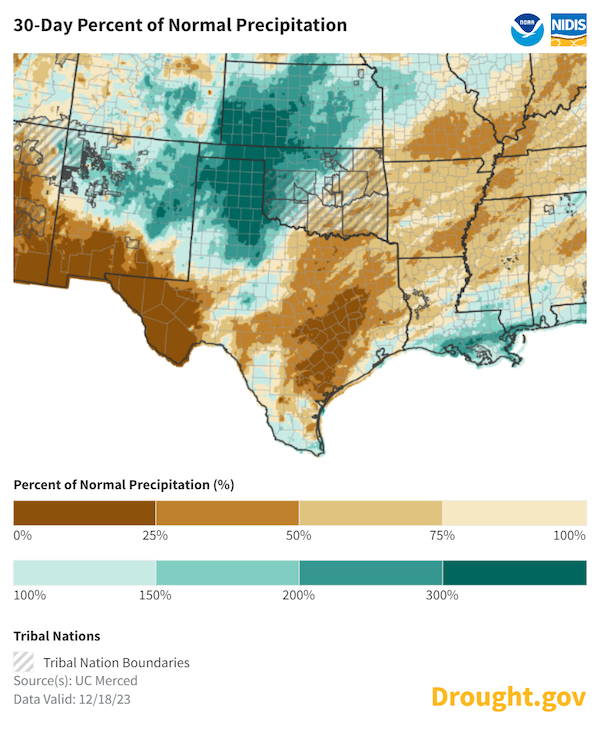
Upper Layer (0–1 meter) Soil Moisture Percentiles
Key Takeaway: Where the precipitation pattern and the temperature pattern are so different, the upper-layer soil moisture provides an indication that the persistent drought is still impacting parts of the Southern Plains. Eastern Texas and Louisiana are still experiencing lingering soil moisture deficits despite recent rain.
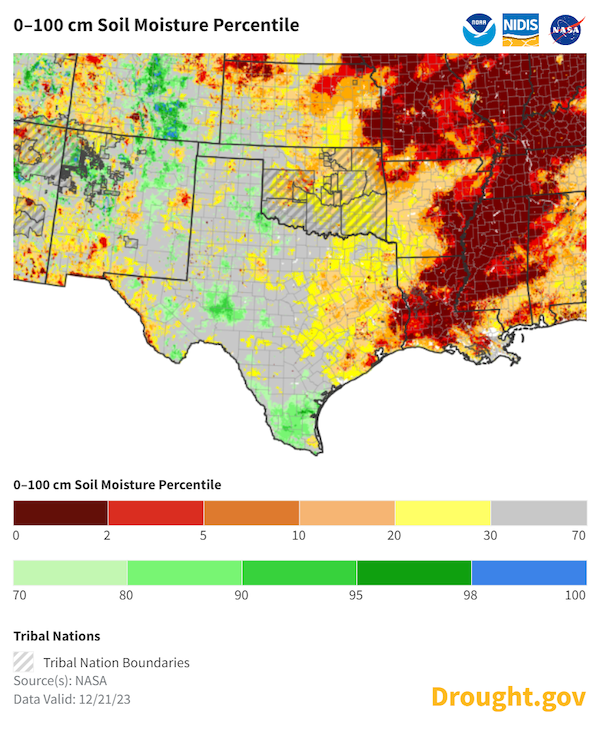
Southern Plains Drought Impacts
- Continued drought conditions in central Texas have led to water restrictions for some cities around the Barton Springs/Edwards Aquifer Conservation District.
- In mid-December, widespread precipitation fell across parts of the Texas and Oklahoma Panhandles and adjacent portions of Colorado and New Mexico. Two to four inches fell slowly over three days.
- Texas Governor Abbott Renews Drought Disaster Declaration In November 2023.
- Summer drought means Monarch butterflies are migrating through Texas in smaller numbers and later than usual this fall.
- In August, Carlsbad, New Mexico issued water restrictions due to relentless heat and lack of rain. Drought has only intensified since then.
Report your local drought impacts through a Condition Monitoring Observer Report:
Texas Reservoir Levels
Key Takeaway: Reservoir levels in eastern Texas improved over the past two months, while reservoir levels in central Texas remained low.
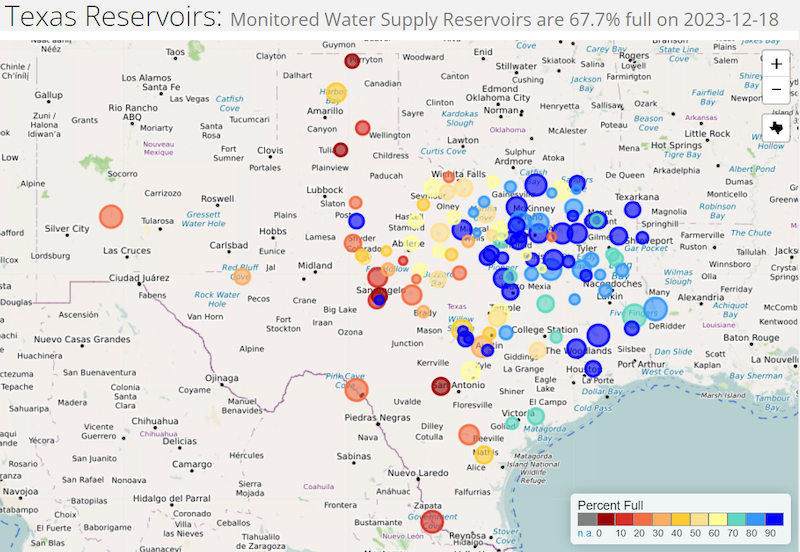
Outlooks & Potential Impacts for the Southern Plains
- The winter months are usually the driest time of the year for Southern Plains states, with January typically being the driest month of the year for Kansas and Oklahoma.
- El Niño (the current state of the central Pacific Ocean) usually, but not always, means a wetter than normal winter for the Southern Plains, with the strongest influence over the gulf coast and far southern Texas.
1-Month Precipitation Outlook for January 2024
Key Takeaway: January precipitation shows an equal chance of above- or below -normal totals across much of the Southern Plains, according to Climate Prediction Center’s outlook.
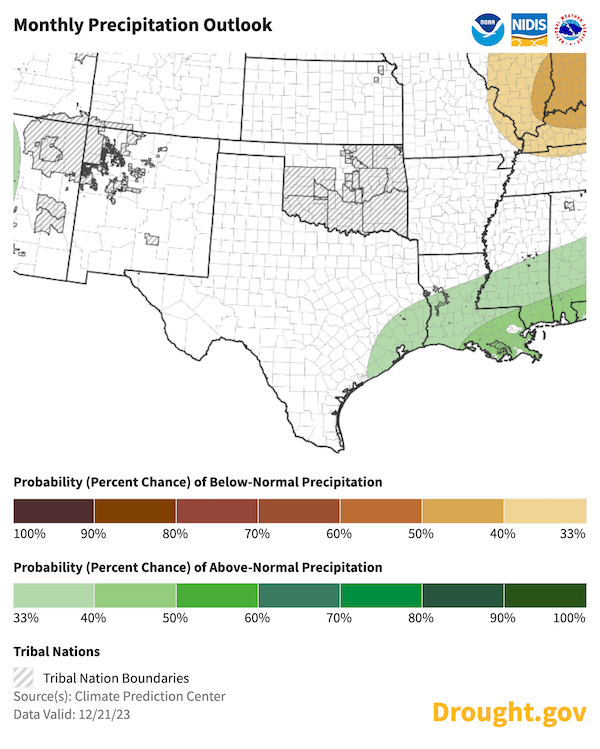
1-Month Temperature Outlook: January 2024
Key Takeaway: January temperature outlook shows an equal chance of above- or below-normal temperatures across all of the Southern Plains, according to Climate Prediction Center’s outlook.
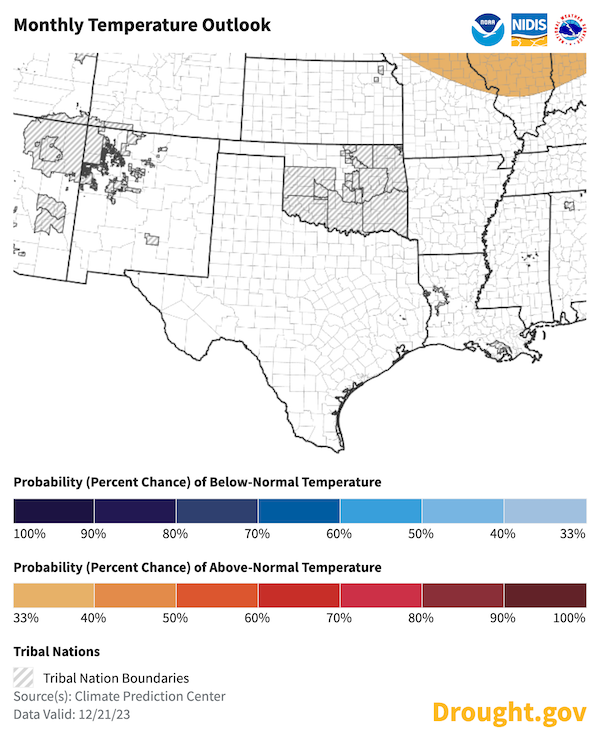
Seasonal (3-Month) Precipitation Outlook for January–March 2024
Key Takeaway: Odds favor above-normal precipitation for western Kansas and eastern Texas. The rest of the region shows an equal chance of above- or below-normal precipitation.
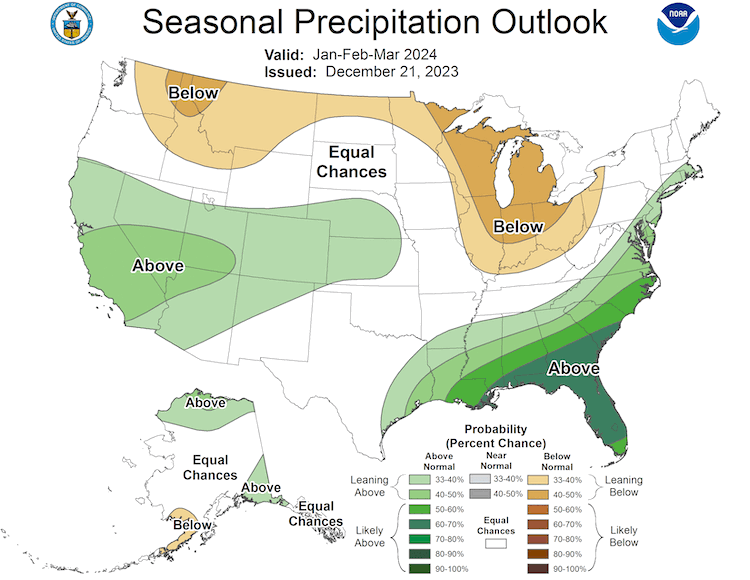
Seasonal (3-Month) Precipitation Outlook for January–March 2024
Key Takeaway: Odds favor near-normal temperatures over Oklahoma and parts of northern Texas and southern Kansas. There are equal chances of above- or-below normal temperatures for the rest of the region.
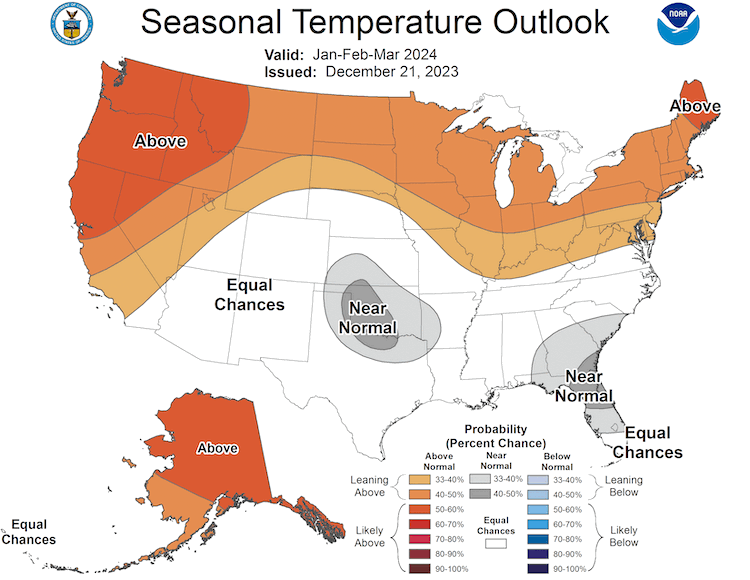
Additional Resources
Regional Resources
- Southern Regional Climate Center
- Water Data for Texas
- Oklahoma Mesonet
- More local information is available from the following resources:
Upcoming Events
- February 21, 2024: Weather and Climate Tools Training for Producers. Woodward, Oklahoma. Email joel.lisonbee@noaa.gov for more information.
- March 18–19, 2024: Ogallala Aquifer Summit. Liberal, Kansas.
In Case You Missed It
- November 29, 2023: NOAA/NIDIS released a New Report on Drought Assessment in a Changing Climate.
Prepared By
Joel Lisonbee, Adam Lang, Kelsey Satalino, and Eleanor Hasenbeck
NOAA’s National Integrated Drought Information System, CIRES/CU Boulder
Gary McManus
Oklahoma State Climatologist, Oklahoma Mesonet, Oklahoma Climatological Survey
Matt Sittel
Kansas Assistant State Climatologist, Kansas State University
John Nielsen-Gammon
Texas State Climatologist, Texas State Climate Office, Texas A&M University
Southern Regional Climate Center
William (BJ) Baule and Alison Tarter
Texas State Climate Office, Texas A&M University
Southern Regional Climate Center
Keith White and Victor Murphy
National Weather Service
This drought status update is issued in partnership between the National Oceanic and Atmospheric Administration (NOAA) and the offices of the state climatologist for Texas, Oklahoma, New Mexico, and Kansas. The purpose of the update is to communicate a potential area of concern for drought expansion and/or development within the Southern Plains based on recent conditions and the upcoming forecast. NIDIS and its partners will issue future drought updates as conditions evolve.








